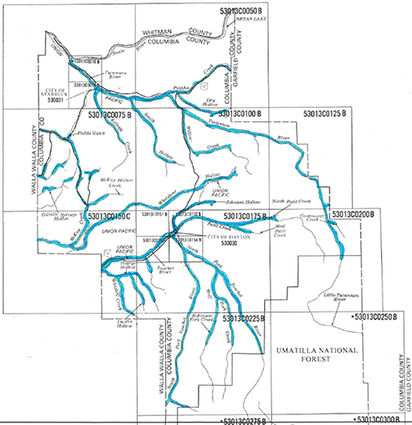Flood Control Zone District Funding Proposal on the November Ballot
October 15, 2020

-Submitted graphic
All watercourses in Columbia County have a history of flooding and have regulated flood plains established by FEMA, and have incurred federal disaster designation seven times since 1964. Flooding damages county infrastructure, which costs the County, City of Dayton, and Town of Starbuck money from their general funds to respond to and repair damage, so for these reasons, the district covers the entire county.
By Chuck Eaton
Columbia County Public Works Director
Special to the Dayton Chronicle
DAYTON–Columbia County's Flood Control Zone District (FCZD), created to establish a county-wide response to the threat of flooding, is proposing a General Excess Levy on the November Ballot.
The proposal before the voters is a 10¢ assessment per $1,000 assessed value, which will raise approximately $100,000 annually for district activities. Additional funds will be sought through grants and agreements in cooperation with other government agencies and private entities.
The FCZD's mission is to reduce the risk of flooding damage to public and private property, accomplished through master planning; construction, reconstruction, and repair of levees, embankments, revetments, and canals; implementation of flood prevention and risk reduction projects; and providing flood-related services for the citizens of Columbia County.
The Columbia County Flood Control Zone District was formed on June 17, 2019 by the Board of County Commissioners (BOCC), in cooperation with the City of Dayton and Town of Starbuck, with resolution 2019-34, pursuant to RCW 86.15.
The General Excess Levy on the November Ballot, if approved, will help adequately maintain and improve the existing levee system as well as provide the other services performed by the district. A FCZD is authorized by state law to collect a property tax or parcel fee for the exclusive use on flood-related activities, programs and functions.
This proposal will not cause any currently funded district to lose funding. The current maximum that would be available to the BOCC to address these issues is $0.03 per $1,000 assessed value, less than 1/3 of projected need.
Without the dedicated funding that would be authorized by the voters, the County will not be able to address existing issues within the County, nor respond to emergency future events.
Since 1964, Columbia County has been declared a federal disaster area seven times due to flooding. The flood this year caused over $7 million in damages to public infrastructure alone. This has taken a serious toll on County budgets. Even with the FEMA, Federal Highways Administration, and Army Corps of Engineers cost-sharing programs, the flood is anticipated to cost the county $1.3 million dollars.
This has resulted in service reductions that affect the entire county. The flood this year has resulted in the reduction, elimination, and/or delay of road maintenance projects, gravel roadway grading, shoulder and ditch maintenance, culvert cleaning, sign maintenance, brush cutting, snow removal, and other critical functions as well as capital improvement projects.
All watercourses in Columbia County have a history of flooding and have regulated flood plains established by FEMA (See figure). In addition to causing damage to county infrastructure, this costs the County, City of Dayton, and Town of Starbuck money from their general funds to respond to and repair damage from flooding.
Maintenance costs to the levees also come from general funds, as does sediment management for the Touchet River in Dayton. For these reasons, the district covers the entire county, including all of the cities. People who have homes or businesses in the floodplain are at more immediate risk, but flooding affects the entire region's economy. When public infrastructure such as roads and levees are damaged, the cost of repair is borne by all county residents. Additionally, the cost of emergency response is also spread county wide.
The district is intended to fill this funding gap by providing dedicated funds for assisting public and private flood protection, flood fighting, and recovery efforts. A funded district could provide these types of services:
• Protect public infrastructure.
• Provide sandbags.
• Provide flood fighting assistance.
• Repair public infrastructure.
• Public and Private Levee Construction, Maintenance and Repairs.
• Obtain grants for flood reduction projects.
• Provide county-wide basin planning.
• Represent public interests before state and federal regulatory agencies.
• Construct, maintain, and operate flood risk reduction facilities.
While a flood may have costs greater than the districts reserves, the district could facilitate coordination of county and cities, and provide an opportunity for them to work together and provide each other assistance with financial documentation, project costs, labor and equipment, and all other aspects of flood response and recovery.
With a dedicated funding source, the levees can receive consistent and prescribed maintenance. Consistent maintenance ensures the levees remain in good condition and may prevent levee failures, such as when the levee was breached during the flood of 1996.







